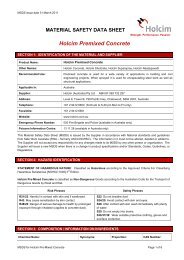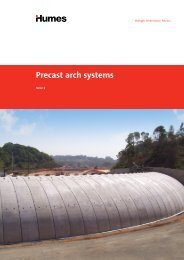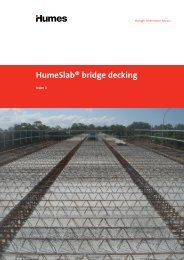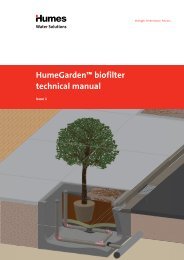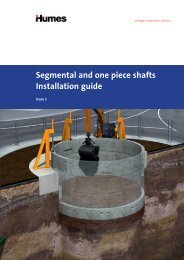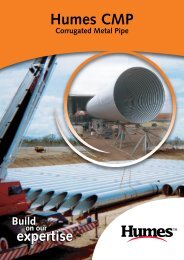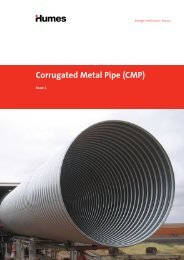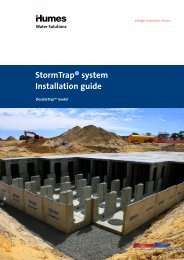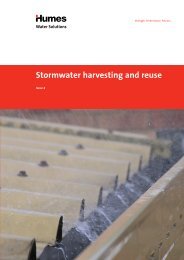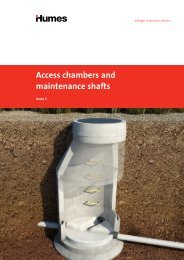Plastiline™ - Humes
Plastiline™ - Humes
Plastiline™ - Humes
You also want an ePaper? Increase the reach of your titles
YUMPU automatically turns print PDFs into web optimized ePapers that Google loves.
8 Laying and jointing of pipes lined<br />
with Plastiline<br />
8.1 This section of the specification is not intended to<br />
cover the laying and jointing of the basic concrete pipe but<br />
deals with the additional jointing requirements arising from<br />
the lining only.<br />
It is essential that care should be taken to prevent damage<br />
to the lining during handling and laying of the pipe.<br />
When pipes lined with Plastiline have been laid and<br />
jointed to form a pipeline, the concrete surfaces at the<br />
circumferential joints must be protected either by<br />
connecting and sealing the linings or by constructing a<br />
special joint.<br />
8.2 Field welded joints shall be either Type P1 or<br />
Type P2.<br />
Type P1 — Special Pipe Joint<br />
using cover strip for butt or flush<br />
or spigot & socket joints or for<br />
pipe to structure<br />
8.3 Field welding of strips associated with joint types P1<br />
and P2 shall be carried out by qualified PVC welders using<br />
approved methods and techniques.<br />
8.4 Welding operators must be trained and accredited by<br />
<strong>Humes</strong> before welding field joints. Proof of welding ability<br />
is required prior to commencing work and approval is based<br />
on the result of tension tests on three sample welds. The<br />
test is carried out according to ASTM D 412 with the<br />
tension transverse to the line of the weld. All samples shall<br />
reach a stress of 13 MPa in the Plastiline sheet away from<br />
the weld, without failure.<br />
8.5 The technique of welding requires the weld strip<br />
to be heat-fused to both sections of the sheet overlapped<br />
by the strip. Particular attention must be given to ensuring<br />
the surfaces to be welded are quite clean and for this<br />
purpose the cleaning agent Applied Chemicals 4480 is<br />
recommended.<br />
8.6 In order to obtain a good quality weld the operator<br />
must achieve the correct temperature to just bring the<br />
mating surfaces to a semi-molten condition. Sufficient<br />
pressure must be applied to force the molten surfaces into<br />
intimate contact until the weld has solidified. Attention<br />
must be given to obtaining weld beads on both sides of the<br />
weld strip (see illust. below). After welding, beads should<br />
be visible on both sides of the weld strip.<br />
Care must be taken not to overheat the Plastiline during<br />
welding. It should be noted that a temperature of 200 O C<br />
or more can cause decomposition of the material. Charring<br />
is evidence of too high a welding temperature.<br />
Type P2 — Normal Pipe Joint<br />
using flap for spigot & socket<br />
joint or butt or flush joints;<br />
straight pipes only<br />
The use of a 100mm flap will not be permitted for splay joints in<br />
reinforced concrete pipelines. Plastiline at splay joints shall be<br />
joined with a type P1 joint.<br />
The Type P1 is used for short length pipes and for splay<br />
joints, and is made by placing a joint strip over the joint,<br />
which is secured and sealed at the edges using two<br />
weld strips.<br />
With the Type P2 joint, which is the most frequently used<br />
for full length pipes in diameters 600mm and larger, a plain<br />
flap of unkeyed lining at the spigot end of one of the<br />
jointed pipes is lapped over the lining of the adjacent pipe<br />
and sealed with a single weld strip.<br />
Plastiline welding plant.<br />
11



